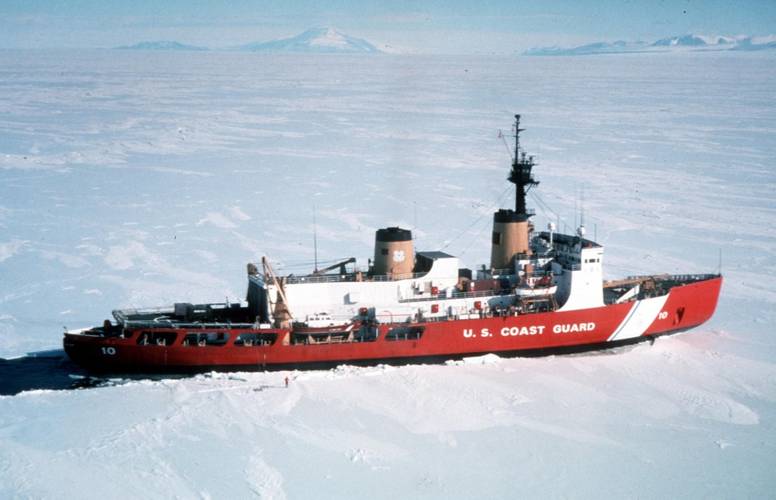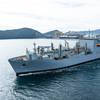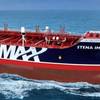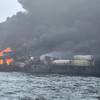Russia has more polar icebreakers than the rest of the world combined. America has one polar icebreaker and that one is well past its prime. There has been talk of sharing icebreakers. Sharing may work with allies, who are generally on the same page. Sharing will not work with Russia, which views the world as a zero-sum game.
In June 2016, Russia announced the launching of Arktika, the world’s largest polar icebreaker. With a full load displacement of 33,540 tons, a length of 173.3 meters and a breadth of 34 meters, it will be capable of breaking ice up to 2.9 meters. Sea trials are scheduled for 2017. It is planned as the first of a series, with the keel of the first of the sister ships already laid. Russia also announced that it is developing a design for an even more powerful class of icebreakers, capable of navigating through ice four to five meters thick and able to transit the Northern Sea Route year-round.
For several years, the National Science Foundation (NSF), administrators of the U.S. Antarctic Program, chartered a Russian icebreaker each Antarctic summer to support its annual resupply voyages to McMurdo Station, called Operation Deep Freeze. Support is now provided by the one USCG polar icebreaker.
The Chinese government has an ice-capable research vessel – Xue Long (Snow Dragon). The vessel conducts research and mission support in both the Antarctic and the Arctic. It is able to run at 1.5 knots in ice up to three feet thick. A second, more capable vessel is under construction. Other nations, such as Argentina, Australia, Chile, France, South Africa, and the U.K. have ice-capable vessels that operate in Antarctic waters.
The U.S. Coast Guard has a strong working relationship with its northern counterpart – the Canadian Coast Guard. In fact, the two entities not infrequently conduct joint operations in the Arctic. The Canadian Coast Guard has one operational polar icebreaker. CCG Louis St. Laurent was commissioned 49 years ago. It is expected to provide an effective presence over an area of the Arctic much greater than that of the U.S. Arctic waters. As with the U.S. situation, the Canadian government has committed to construction of a replacement icebreaker, but funding has yet to be identified.
The time is long overdue for the Administration and Congress to work toward the common goal of reasserting the U.S. in the polar regions. At the end of World War II, the U.S. had the largest fleet of icebreakers in the world. Those icebreakers were not nearly as capable as modern technology now allows, but they got the job done. They facilitated the exploration of the Antarctic and the building of the Dew Line, among other things.
Not long after the polar icebreakers USCGC Polar Star and USCG Polar Sea entered active service in 1976 and 1977 respectively, the last of the Wind class icebreakers, as well as the USS/USCG Glacier, were decommissioned. The Polar Sea was taken out of service in 2010 due to major engineering problems. The medium icebreaker USCGC Healy entered service in 1999, but its ability to operate in heavy ice is limited, as evidenced by the difficulty experienced in escorting the tanker bringing emergency fuel to Nome in January 2012.
The current situation did not occur overnight. Many have warned of the problem, but few have listened and none have acted. The various Administrations have not, until now, budgeted for construction of a new icebreaker. Congress has conducted several hearings, but never, until now, shown interest in appropriating funds. It is doubtful if this Administration and this Congress, both in their last few months, will actually appropriate the monies needed to do any more than kick the can down the road.
The US Coast Guard has drawn up a basic plan for construction of a new polar icebreaker, but this is the most that it can do without Congressional approval. President Obama recently announced steps to accelerate the acquisition of additional icebreakers and there has been increasing support for this initiative in Congress, but Mister Green has yet to make a meaningful appearance.
The Coast Guard believes that six icebreakers are needed to satisfy the strategic needs of the U.S. in the polar regions. For now, though, it will settle for one new polar icebreaker. Its ‘needs list’ provides for a vessel that can move at a continuous speed of three knots through six-feet-thick ice and, by backing and ramming, break through a 21-foot-thick ice ridge. It must be able to operate in air temperatures from -72° F to 114° F and in water temperatures from 28.8° F to 87° F. With a crew of approximately 100, plus scientific personnel, it must be capable of deployment for at least 80 days. It must be able to launch, land, and support helicopters and to tow ocean-going vessels in the ice. It must also be capable of supporting a wide range of scientific activity.
The Coast Guard envisions its icebreakers to be equipped with .50 caliber machine guns. I advocate that they be designed so that heavier weapons can installed quickly, should the need arise.
Nuclear power would provide a number of advantages, but is impractical for U.S. icebreakers for a number of reasons.
While the Administration has limited its request to funding for one new icebreaker, Representative Duncan Hunter (R-CA), chair of the House Subcommittee on Coast Guard and Maritime Transportation, has called for funding for multiple icebreakers. I recommend that the U.S. commit itself to the construction of one new polar icebreaker every five years for the foreseeable future. Thus, as one of the fleet of six icebreakers reaches the end of its service life, there will be a new replacement coming down the ways. Since building of a new icebreaker is projected to take five years, this suggested construction program could hit a sweet spot. This program would also encourage US shipyards to take the project seriously and plan for the long term rather than as a one-off effort. Congress recently appropriated $7 million for preliminary design work on a new polar icebreaker.
Climate change has allowed increased maritime traffic through the Northern Sea Route north of Russia and through the Northwest Passage north of Alaska and the Canadian mainland. The recent transit of the cruise ship Crystal Serenity through the Northwest Passage has highlighted the dire status of Arctic infrastructure. Charts of those waters are inadequate. Search and rescue capability is sparse. Pollution response and salvage capability is virtually nonexistent.
The U.S. Navy has no ice-capable surface vessels. It relies wholly on the U.S. Coast Guard for surface vessel force projection in the polar regions, except when those waters are relatively ice-free. Given the current state of the USCG icebreaker fleet, American national security and homeland security in the polar regions is at risk.
America needs icebreakers, not more talk.
The Author
Dennis L. Bryant is with Bryant’s Maritime Consulting, and a regular contributor to Maritime Reporter & Engineering News as well as online at MaritimeProfessional.com.
t: 1 352 692 5493

















